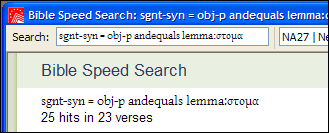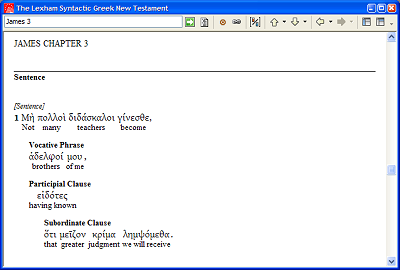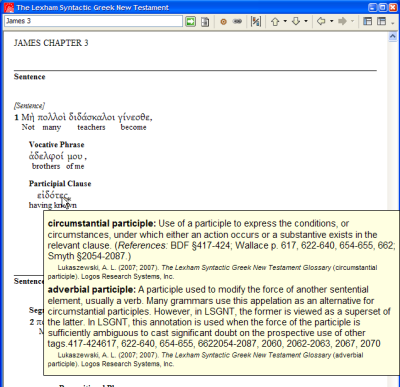First, a teaser. Here’s where we’re going:
Mixing syntactic force and lemmas in a Bible Speed Search?!
However, there’s another view, one I like to call the “running text” view. This has the text of the Greek New Testament (UBS/NA) but it has one clause on each line, with indentations to show the relationships. This view is also an interlinear. The resource is The Lexham Syntactic Greek New Testament, shortname is LEXHAMSGNT. Here’s an example, note that I have my interlinear configured to only show the Greek text and the English gloss line (you can control this in View | Interlinear).
Now, what not many people know about this edition of the Lexham SGNT is that it is tagged for Syntactic Force. This is what many people refer to as “syntax” when they talk about the Greek of the New Testament, and it is the sort of thing that many second-year programs at seminaries and colleges dig into. You can see the clause and phrase breaks and the hierarchy implied by indentation; what you can’t see is that each word carries a syntactic force annotation. So, in the above example, when I hover over ειδοτες, a popup informs me that this could be either a circumstantial participle or an adverbial participle. Definitions of these terms are given as well.
Did you know that you can search for this kind of thing using the Bible Speed Search report? It’s a little verbose, but possible: sgnt-syn = “circumstantial participle” andequals lemma:οιδα In the material covered by the Lexham SGNT, this happens 10 times (I know because I just did the search).
This is just one example; I made a video that explains things a little more. This combines a few different advanced concepts: non-Bible data type searching, the andequals operator (also note the notequals operator) and using the lemma field. But it allows you to find some pretty specific things. Like, copulative conjunctions that aren’t και.
To further facilitate this kind of searching, I’ve also compiled a list of valid syntactic force codes that you can key into the Bible Speed Search dialog. So, instead of having to type “circumstantial participle”, you’d know you could instead type “ptc-circum”. You can download this file (PDF); hopefully it’ll help in your use of the Lexham SGNT.
Lastly, I should note that the Lexham SGNT is a work in progress; at present it includes annotations of Romans-Galatians and Hebrews through Revelation. If you find annotations that you don’t agree with or would like to suggest alternate annotations, we want to know about it. Send an email to syntax@logos.com and we’ll make sure it gets to the editor.







